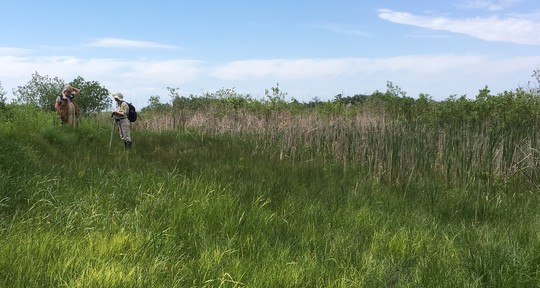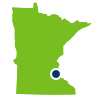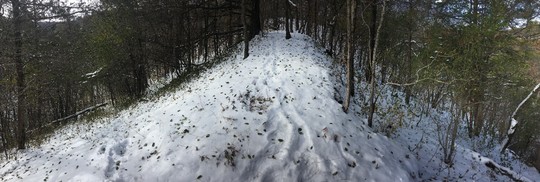Happy Farming Mel!
Introduction by David Minor, SNA communications outreach specialist
Melissa Driscoll has been with the Scientific and Natural Areas (SNA) Program since 2004. On February 27, 2020 she moved on from her position as the SNA Acquisition Coordinator to work full time at her organic farm! From 2004 to 2005 she counted birds, collected breeding data, and created bird lists for the SNA Program in the Northwest region of the state. Then in late fall of 2005 she got a job negotiating Native Prairie Bank (NPB) easements. Around 2010 she started working on SNA Acquisitions, and became the SNA Acquisition Coordinator after the former coordinator, Lee Markell, retired. Thank you Mel for your many years of dedication and expertise!
Melissa Driscoll with a Native Prairie Bank landowner, Bryce Gens, on closing day. Photo by MN DNR.
What is the best part about your job?
I think the BEST part of my job is when, after years of work, the parcel closes. This means we own it, and it will be managed as an SNA. It takes so long to get to that point that when we get there I just love it!
What gets you excited about your work?
I get excited when a “perfect” addition to an SNA is on the market, and the landowner wants to sell to the SNA Program. I also love collaborating and learning from our partners in the Minnesota Biological Survey (MBS) or the regional ecologists. I love learning some new fact about how protecting land makes it possible for a bird, or turtle, or butterfly to survive.
What are the challenges of this line of work?
The biggest challenge of this work is building trust between the landowner and the Department of Natural Resources (DNR), with me as the conduit. It takes the DNR at least a year to buy a parcel of land, often longer. This is very different from the regular real estate market where once you sign a purchase agreement you may close in 60 days. Also, our system inside the DNR passes landowners from person to person. Once trust is built with field staff, the landowner might work with me, then with a Lands and Minerals (LAM) Project Manager. Each hand-off has the potential to lose the landowner’s trust. And you might not notice that loss until an offer is presented to the landowner and they say no.
What is your favorite way to spend time outdoors?
My favorite way to be outdoors is probably canoeing, but I love to hike, play soccer, walk the dog, cross-country ski, play soccer, even weed! It is very important for me to spend lots of time outside.
What is your favorite SNA?
I have not seen all of them but I love rolling prairie, so I will say Blanket Flower Prairie SNA. I was once there as the sun came up and prairie chickens were dancing in the sunrise on the next ridge over. Just awesome!
Is there anything else you’d like to share?
I have enjoyed collaborating with everyone inside and outside the SNA Program, at the DNR. I don’t think you can run government like a business, but I do think we can continually improve how we do things. At some point we will be done buying land, and we will be managing what we have. I think we have to find a way to lift up our management stories. Buying land is fun and exciting, but the real important work is that on-the-ground management after the land is purchased.
What’s next for you?
I started farming in 2010, and soon after I went to ¾ time at the DNR (in order to have more time to farm). Now I plan to farm full time! My farm is called Seven Songs Organic Farm and you can find my food in locally-made products like You Betcha Kimchee, Well-Rooted Teas, Serious Jams, and my own Escape! Garlic Scape Pesto. I sell produce through The Gentleman Forager, and that company has a small store (with a huge tower of growing mushrooms!) at Keg and Case Market, on West 7th St. in St. Paul. I sell my pesto there and at some of the local co-ops. I am considering running for public office, plan to do more home remodeling, and will continue playing with my soccer team and attending Wanamingo strength classes. I also plan to spend more time with my Dad, my siblings, and my nieces and nephews.
Melissa Driscoll with a Great Grey Owl. Photo courtesy Melissa Driscoll.
Back to top
The Rare and Wild: Calcareous Fens
Learn more about one of the rare native plant communities that Scientific and Natural Areas protect in this 2020 series about the “Rare and Wild” in Minnesota!
Contributions by Megan Benage, regional plant ecologist; Becky Marty, regional plant ecologist; Michele Walker, groundwater hydrologist; and Doug Norris, wetlands program coordinator.
Becky Marty, on the right, a Minnesota Department of Natural Resources (DNR) regional plant ecologist, and Michele Walker, on the left, a Minnesota DNR groundwater hydrologist, in a northwestern Minnesota fen. Photo by Doug Norris.
What are they?
Calcareous fens are rare and distinctive peat-accumulating wetlands. They depend on a constant supply of cold upwelling groundwater rich in calcium and other minerals. This cold calcium-rich environment supports a diverse assemblage of plants, including several rare species, that tolerate the low oxygen conditions, calcium carbonate deposits, low nutrient availability, and relatively cold organic soils (peat) that are found in the fens. These are the things that define a calcareous fen ecosystem. A note of caution: they can be quite treacherous to walk in, and they are very sensitive. Foot traffic can easily damage the ecological community.
Where are they in Minnesota?
They are found associated with remnant glacial features of calcareous drift left during the last phase of the Pleistocene glaciation. This is predominately in northwestern and western Minnesota, along the Minnesota River Valley, and in the limestone-dominated (karst) geologic regions of southeast Minnesota.
Why are they important?
Healthy fens are a good indicator of stable groundwater systems and might be called the goldilocks habitat. They need just the right amount and type of water to exist — not too much and not too little. Because they rely on a constant supply of groundwater, activities that affect groundwater can impact these fens; even 5 miles away. Healthy fens also are an invaluable part of Minnesota’s rich natural heritage because they are ecological refuges for several rare and endangered species. If you see one, inhale its pungent smell and enjoy the trickle of groundwater flowing in channels through a series of marly (crumbly calcium rich deposits) pools. If you’re lucky, you will get to enjoy blooming wildflowers as well as butterflies and birds that may be found in them.
Who works on them?
Megan Benage is an ecologist with the DNR who works on calcareous fens in south and southwest Minnesota. She ventures out with fellow scientists, Anne Hall and Keylor Andrews, to assess the status of fens across southern Minnesota each summer in June and August, when the fen indicator plants are most recognizable. They collect data on the four things it takes to make a fen a calcareous fen: highly organic soils (peat), calcium-loving plants (also known as calciphiles if you want to impress your friends), groundwater-fed, and the right chemistry. They use this data to understand how these 4,000 plus year old communities are doing.
Michele Walker is a groundwater hydrologist with the DNR who works in calcareous fens in central and northwest Minnesota. She and Becky Marty, Megan’s counterpart in the northwest, visit fens in June and August. Keylor sometimes joins them, as well as Rosalyn Nelson, another hydrologist. They collect similar data to Megan’s group, but it is orientated to the unique geologic and floristic characteristics of the central and northwest parts of Minnesota. Much of the data they collect is used to assess the health and vibrancy of these communities. Pooling this information with the work from Megan’s group and others, they develop monitoring plans and make recommendations on how to maintain or restore these fragile and unique wetlands.
 Greg Goeser, a private geologist, and Anne Hall, a Minnesota Department of Natural Resources groundwater appropriations hydrologist, discuss how ‘fentastic’ this calcareous fen in Kandiyohi County, Minnesota really is. Photo by Megan Benage.
Back to top

Site Highlight: Grey Cloud Dunes SNA
David Minor, SNA communications outreach specialist
|
Birdfoot violets in sand dunes at Grey Cloud Dunes SNA. Photo © ColdSnap Photography.
Getting to know a place takes a long time. Though it helps if you do your homework and go with someone who is familiar with it. I have visited Grey Cloud Dunes SNA multiple times, the first being just over one year ago, in early 2019. On each following visit, my experience changed as I saw and learned more.
When I first walked on site, I’ll be honest, I thought it was a little cold and desolate. There was no sign of life to my eyes, just stems of dead grass (little did I suspect the large diversity of “grasses” I was looking past). The thick February sky hung heavy, so I could not see down from the high terrace. I could not see the rolling dunes, the sweeping landscape, the river below. At least this SNA was living up to its cloudy name so far, I thought. It’s amazing how much an inexperienced, untrained eye can miss. On the other hand, maybe the snow was to blame.
I visited the site again in April, on a cold, rainy day. So far, it’s two for two on the name. This time though, I knew a little more. I began to notice the story of the land, or at least one of the stories. As I walked through last year’s grass, I could feel the earth gently rise and fall, mounded into rows of an old cultivated field that is now being restored to prairie.
During a volunteer event in June, I discovered this place isn’t always gray and cloudy! The sun had come out, and with it the blooming wildflowers in the prairie. I think this is also when I was able to look down across the river from the dunes and started to try to understand the space: high terraces, rolling topography, the present day Mississippi far below the bluff line. The Glacial River Warren, which once flowed through here, must have been torrential.
Back at the office, I looked through some older photographs of the site. I had learned that before it was designated as an SNA, it was a popular spot for ATV use. The photographs told a different story than what I saw in person. They showed large areas of bare, churned up sand. Not a speck of life in what looked like a veritable desert. I did not see anything like this in my visits. Just the small sand blow-outs, which offer habitat for sea beach needle grass (MN Threatened). It looks like it has changed a lot.
Churned up sand dunes at Grey Cloud Dunes SNA. Photo © ColdSnap Photography.
I returned to the site a few more times throughout the year, helping with volunteer events and taking photographs, learning more and seeing more each time. Each time I saw something different. Like the multitude of wildflowers, which took turns blooming through the year. When you return to a place and see it throughout the year, you can begin to know and appreciate its many expressions. When you help take care of the land, you can begin to understand the immense effort and impact that so many have had to protect and preserve it.
I most recently visited Grey Cloud Dunes SNA in November, during a seed collection event. Though I confess, I was more occupied with my camera, trying to capture the beautiful “leftovers” of the year. I sat in a sea of little bluestem watching it lazily wave back and forth. So much had gone to seed. It looked prepared for a long winter, ready to begin again in the spring. Except, a single, unseasonable, birdfoot violet that a volunteer found, which normally blooms in April and May. You never know what you will see when you visit, but if you slow down, look closer and ask questions, you might be pleasantly surprised.
During a lunch break at a volunteer event, I sat in a sea of little bluestem, watching it wave lazily back and forth. Photo by David Minor.
If you decide to visit Grey Cloud Dunes SNA for yourself, remember that there are no maintained trails or facilities, so please come prepared. Each season has something special to offer. Spring and summer are wonderful, with many different wildflowers blooming through the seasons. Spring and fall offer views of raptors and waterfowl as they migrate along the Mississippi. Winter will give you quiet and solitude with vistas of sky and still golden prairie grasses. Volunteer events are a great way to experience this site. Keep an eye on the calendar of upcoming events as they are planned for the year. Join in to learn more about this special place and help protect it.
Back to top

SNA Events
All March and April SNA events have been canceled. Be sure to check the website for an updated list and more information.
Honeybee on pasque flower (Anemone patens) at Pin Oak Prairie SNA. Photo by Kelly Randall.
Back to top

Notes from Site Stewards
Site stewards monitor SNAs across Minnesota. Their observations provide valuable information to the SNA Program. Here are some interesting notes from recent reports.
- Site steward Bruce West visited Frenchman’s Bluff SNA in early winter and noted the autumn grasses, many gopher and badger mounds, and mowed firebreaks in preparation for spring burn season.
- Site steward Jerry Zimny visited Hemlock Ravine SNA on December 23 and noted that the deer exclosure fence on the site is working well. “No critter tracks inside exclosure. Many deer tracks and beds outside. Fence is doing its job!”
- Jake Stacken, the site steward at Wykoff Balsam Fir SNA, spent the day removing buckthorn and other invasives from a bluff prairie in the site on February 28. Jake notes that this is an exciting project since “the bluff is the confluence of two rare and contrasting bluffland ecosystems: oak savanna/bluff prairie and an algific talus slope with a maderate cliff beneath. There is a balsam fir and prairie grasses growing within a few yards of one another! Very exciting. Much work is needed to restore this gem and we are eager to be back there again soon.”
- Jim and Sonja Hruska, the site stewards for Iron Horse Prairie SNA, snowshoed into the prairie and saw many different animal tracks and two hen pheasants on February 23, and noted that the SNA crew did a nice job on invasive brush removal in the prairie.
 |
Winter bluff at Wykoff Balsam Fir SNA. Steward Jake Stacken has begun brush removal to help restore the small, bluffland ecosystem. Photo by Jake Stacken.
Thanks for all the work you do, SNA stewards!
Back to top

|